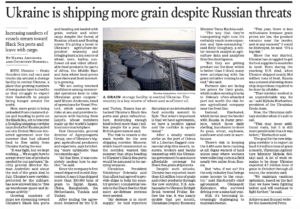The USDA is projecting that the ag trade deficit will shrink in FY2026 even more than previously anticipated. USDA expects the trade deficit to fall from $43.7 billion in FY2025…
Ukraine “Shipping More Grain” as Threats Persist, While Storm Batters Black Sea Region
Associated Press writers Hanna Arhirova and Courtney Bonnell reported in today’s Los Angeles Times that, “Grain thunders into rail cars and trucks zip around a storage facility in central Ukraine, a place that growing numbers of companies have turned to as they struggle to export their foodstuffs to people facing hunger around the world.

“Now, more grain is getting unloaded from crammed silos and heading to ports on the Black Sea, set to traverse a fledgling shipping corridor launched after Russia pulled out of a United Nations-brokered agreement over the summer that had allowed food to flow safely from Ukraine during the war.”
Growing numbers of ships are streaming toward Ukraine’s Black Sea ports and heading out loaded with grain, metals and other cargo despite the threat of Russian attack and floating mines.
“It’s giving a boost to Ukraine’s agriculture-dependent economy and bringing back a key source of wheat, corn, barley, sunflower oil and other affordable food products for parts of Africa, the Middle East and Asia where local prices have risen and food insecurity is growing.”
Today’s article noted that, “‘We are seeing renewed confidence among commercial operators keen to take Ukrainian grain cargoes,’ said Munro Anderson, head of operations for Vessel Protect, which assesses war risks at sea and provides insurance with backing from Lloyd’s, whose members make up the world’s largest insurance marketplace.”
Nonetheless, today’s article explained that, “The goal for the new shipping corridor is to export at least 6.6 million tons of grain a month, Ukrainian Agriculture Minister Mykola Solskyi said. It has a lot of work to do: Ukraine exported 4.7 million tons of grain in October through all routes, the ministry said.
“‘We maintain cautious optimism, based on the fact that we have been fighting before and will continue to fight further,’ he said.”
Meanwhile, Marc Santora reported in today’s New York Times that, “A powerful wintry storm battered southern Ukraine on Monday, washing away Russian coastal defenses from some beaches on the occupied Crimean Peninsula. The storm, which Ukrainian meteorologists said was among the most intense in decades, snarled supply routes for both countries’ armies and deepened the misery of tens of thousands of soldiers huddled in shallow trenches across the sprawling front line.”
“Violent waves stirred by hurricane-force winds threatened to tear maritime mines from their moorings in the Sea of Azov and the Black Sea — as less violent storms have done in the past — complicating the navigation of already dangerous shipping lanes,” the Times article said.
And Dan Stillman reported in today’s Washington Post that, “Weather models showed that winds could flare up again Tuesday in the northwestern Black Sea ahead of yet another storm that could bring heavy rain and snow to the region.”
Bloomberg News reported yesterday that, “A Black Sea storm halted loadings of crude and grains from key ports in Russia and Ukraine and left more than a million people across the region without power.”
The article added that, “Shipments from Ukraine’s greater Odesa ports via the Black Sea have been halted due to the weather, according to people in the sector familiar with the matter. Ukraine’s infrastructure ministry didn’t immediately respond to a request for comment.”
Elsewhere, Reuters writer Julie Ingwersen reported yesterday that, “The U.S. Department of Agriculture (USDA) on Monday rated 50% of the U.S. winter wheat crop in good-to-excellent condition, up two percentage points from last week and a bigger improvement than most analysts expected.

“The good-to-excellent rating was the highest for this time of year in four years, favoring production prospects in the world’s No. 4 wheat exporter and potentially easing fears of tightening global grain supplies. However, dry conditions persist in key areas including Kansas, the top winter wheat growing state. As always, the U.S. crop’s potential will be highly dependent on springtime weather.”
Here's how this year's late November winter #wheat ratings compare to past years vs eventual yields. #oatt pic.twitter.com/sApNUAqN2T
— Arlan Suderman (@ArlanFF101) November 27, 2023
Ingwersen explained that, “The USDA’s two-point rise in ratings came as soil moisture levels increased. The share of U.S. winter wheat production located in a drought area fell to 41% by Nov. 21, down from 44% the previous week and down significantly from 75% a year earlier, according to the USDA. A foot (30.5 cm) of snow fell in parts of south-central Kansas over the weekend, the National Weather Service said.
Approximately 41% of winter #wheat production is within an area experiencing #drought. pic.twitter.com/Qj96FWsjSM
— FarmPolicy (@FarmPolicy) November 22, 2023
“Meanwhile, the U.S. fall harvest is virtually finished. The U.S. corn crop was 96% harvested by Sunday, the USDA said, behind the average trade estimate of 97% but ahead of the five-year average of 95%. The U.S. soybean harvest was 95% complete by Nov. 12, the government reported previously.”
Reuters writer Naveen Thukral reported today that, “Brazil’s 2023/24 soybean planting had reached 74% of the expected area as of Thursday, agribusiness consultancy AgRural said on Monday, making it the slowest progress for the period in eight years as the country grapples with bad weather.
“Sowing was up 6 percentage points from the previous week but continued to lag far behind last year’s levels when 87% of the areas had been planted at the same time and is now the slowest since 2015/16.”





